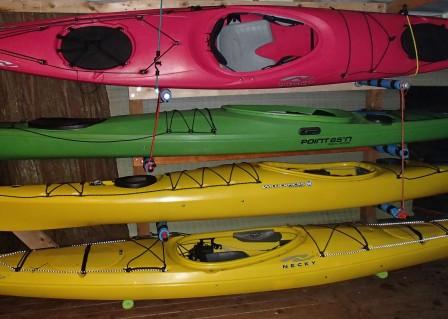Buying a sea kayak can seem like a complicated process. We often are asked about the differences in the materials used to build sea kayaks, and many people are drawn to plastic boats because of their comparatively low price and reputation for not needing much care. While the first consideration is true, a “put away and forget” attitude toward a plastic kayak may result in future unhappiness!
So, let’s talk briefly about what a “plastic” kayak is. They’re made of polyethylene plastic, heat molded by various processes so that the hull and deck form a single unit that only requires cutting out the hatch and cockpit openings and attaching the outfitting (seat, deck and carry lines, bungee cords, etc.). By contrast, composite boats made of fiberglass and other materials, have the deck and hull made separately, then joined together. The composite materials are more expensive and require much more labor to construct. Consequently, the resulting boats are more expensive.
The advantages of plastic kayaks are durability, particularly if dropped on a hard surface or from impact while paddling; and as mentioned before, this construction results in the lowest prices for both brand new and used boats. There are limits to the “no care” concept, however, as you’ll see below.
There are several disadvantages of plastic when compared to other materials. The first is weight; plastic kayaks are heavy. Full size, 16-17’ length plastic sea kayaks will weigh 60-70 lbs. or more, while composites can be 20-25% lighter. Dragging over rough surfaces will wear “furry” gouges into the hull, and that “fur” will slow the boat as it moves through the water. Some will find plastic boats to flex considerably more in rough water than a composite kayak, which can result in less control; but on calm waters, few would notice a difference.
Since UV light degrades polyethylene, storage inside or under cover is essential. Periodic spraying with 303 Protectant is recommended. Finally, if storing on a rack (or suspended by straps), it’s VITAL to match the supports to the interior bulkheads! If you don’t, the boat can be warped or “oil canned.” Sometimes oil canning can be repaired, but it’s a tricky job and not for the fainthearted. Leaving a plastic boat tightly tied down on your roof rack on a hot day can do the same damage, or even turn your prized kayak into a colorful banana.
ALL kayaks and gear, regardless of construction materials, should be rinsed thoroughly (inside and out) after paddling in salt water! So, there is no advantage of plastic over other materials from this standpoint. Salt is corrosive and abrasive and needs to be removed as quickly as is practical.
Note the accompanying photo which shows supports matching (or nearly so) the bulkhead positions. Storing on the boat’s side also will help preserve its shape. We at SSKS hope this information is helpful, and we’ll be happy to answer any questions you care to send us. Happy Paddling!




